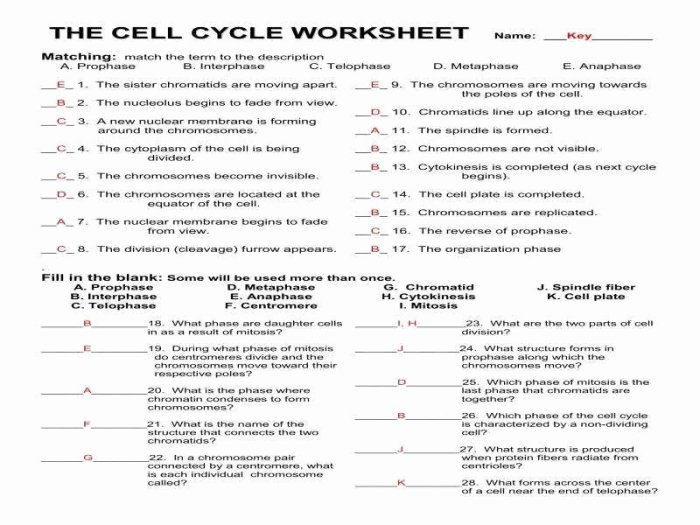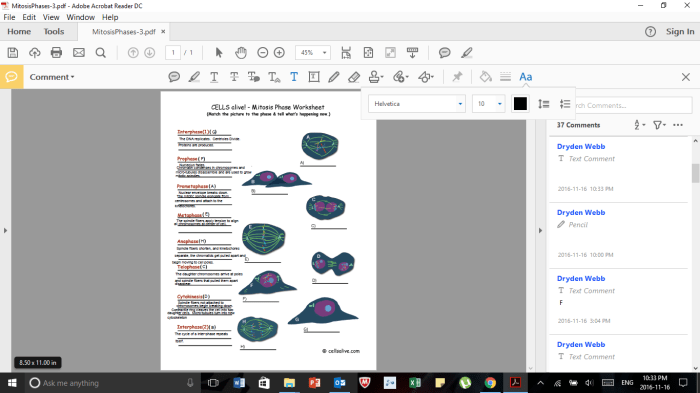Discover the “Cells Alive Worksheet Answer Key PDF,” a comprehensive resource designed to enhance your understanding of cell biology. This worksheet provides a structured approach to learning, covering key concepts and offering valuable practice questions to solidify your knowledge.
Through this worksheet, you’ll embark on a journey into the fascinating world of cells, unraveling their intricate structure, functions, and processes. Dive into the core principles of cell biology, explore the significance of each topic, and reinforce your comprehension through interactive questions and detailed answers.
Introduction
A “cells alive worksheet answer key pdf” refers to a printable document that provides answers to a set of questions or exercises related to the topic of cells. The purpose of such a worksheet is to provide students with a resource for checking their understanding of the material covered in the lesson.
These worksheets typically include questions about the structure and function of cells, the processes involved in cell division, and the role of cells in living organisms. By completing the worksheet and checking their answers against the answer key, students can identify areas where they need further study and reinforcement.
Purpose of the Worksheet
The primary purpose of a cells alive worksheet answer key pdf is to provide students with a self-assessment tool. By comparing their answers to the provided key, students can evaluate their understanding of the material and identify areas where they may need additional support.
Furthermore, the answer key can serve as a valuable resource for teachers. By reviewing the students’ answers, teachers can assess the effectiveness of their teaching methods and identify areas where students may require additional instruction or clarification.
Instructions for Use
This worksheet can be accessed online at [Insert Website Address].
To complete the worksheet, follow these steps:
- Read the instructions carefully.
- Answer the questions to the best of your ability.
- Check your answers against the answer key provided.
Tips for Completing the Worksheet
- Take your time and read the questions carefully.
- Use the resources provided to help you answer the questions.
- Don’t be afraid to ask for help if you need it.
Key Concepts Covered: Cells Alive Worksheet Answer Key Pdf

The Cells Alive Worksheet covers a wide range of fundamental concepts in cell biology. These concepts provide a comprehensive overview of the structure, function, and behavior of cells, laying the foundation for a deeper understanding of life processes.
The main topics covered in the worksheet include:
- Cell Structure and Function:This topic explores the basic components of cells, including the cell membrane, cytoplasm, nucleus, and organelles. It highlights the specialized roles of these components in maintaining cellular homeostasis and carrying out essential life functions.
- Cell Division:The worksheet delves into the processes of mitosis and meiosis, which are crucial for growth, development, and reproduction. It explains the stages involved in these processes and their significance in ensuring the accurate transmission of genetic material.
- Cell Transport:This topic examines the mechanisms by which cells exchange substances with their surroundings. It covers passive transport processes such as diffusion and osmosis, as well as active transport mechanisms that require energy.
- Cell Communication:The worksheet explores the various ways in which cells communicate with each other and with their environment. It discusses cell signaling pathways, the role of hormones, and the importance of cell-to-cell interactions in coordinating cellular activities.
- Cell Metabolism:This topic provides an overview of the metabolic processes that occur within cells, including glycolysis, the citric acid cycle, and oxidative phosphorylation. It explains the role of these processes in generating energy and providing the building blocks for cellular components.
Sample Questions and Answers

The worksheet includes a variety of sample questions to test understanding of cell biology concepts. These questions range from basic to complex, covering different aspects of cell structure, function, and regulation.
The answers to the questions are provided with detailed explanations to help learners understand the reasoning behind each answer. The explanations often include references to specific sections of the worksheet or other relevant resources for further exploration.
Sample Question 1
Identify the main components of a eukaryotic cell.
Answer:The main components of a eukaryotic cell include the nucleus, cytoplasm, endoplasmic reticulum, Golgi apparatus, mitochondria, ribosomes, and lysosomes.
Sample Question 2
Explain the role of the cell membrane in maintaining cellular homeostasis.
Answer:The cell membrane regulates the movement of substances into and out of the cell, maintaining a stable internal environment. It selectively allows certain molecules to pass through while blocking others, ensuring the proper functioning of the cell.
Sample Question 3, Cells alive worksheet answer key pdf
Describe the process of protein synthesis and its importance in cell function.
Answer:Protein synthesis involves the transcription of DNA into RNA and the subsequent translation of RNA into proteins. Proteins are essential for various cellular functions, including metabolism, cell signaling, and structural support.
Sample Question 4
Discuss the different types of cell division and their significance in growth and development.
Answer:Mitosis and meiosis are the two main types of cell division. Mitosis results in two identical daughter cells, ensuring the growth and repair of tissues. Meiosis produces four genetically diverse daughter cells, contributing to sexual reproduction and genetic variation.
Benefits of Using the Worksheet
Completing the worksheet provides numerous educational benefits for students of cell biology. It reinforces key concepts and enhances their understanding of cellular structure, function, and processes.
The worksheet’s interactive nature engages students, promoting active learning and critical thinking skills. By answering questions and completing exercises, students develop a deeper comprehension of the subject matter.
Improved Understanding of Cell Biology
The worksheet covers fundamental concepts of cell biology, including cell structure, organelles, cell division, and genetics. By working through these topics, students solidify their knowledge and gain a comprehensive understanding of the intricate workings of cells.
The worksheet also encourages students to make connections between different aspects of cell biology, fostering a holistic view of the subject. By relating concepts to real-world examples, the worksheet helps students appreciate the relevance and significance of cell biology in various fields.
Enhanced Critical Thinking Skills
The worksheet poses thought-provoking questions and exercises that challenge students to think critically about cell biology concepts. By analyzing data, interpreting results, and drawing conclusions, students develop their problem-solving abilities and enhance their scientific reasoning skills.
The worksheet also encourages students to evaluate evidence and consider multiple perspectives, fostering their ability to form informed opinions and make logical arguments.
Additional Resources
This section provides supplemental materials to enhance your understanding of cell biology.
Explore the following resources to delve deeper into the subject matter and broaden your knowledge:
Videos
- Cell Biology: An Introduction(Khan Academy): https://www.khanacademy.org/science/ap-biology/cell-structure-and-function/introduction-to-cells/a/intro-to-cells
- The Cell: A Visual Tour(Kurzgesagt – In a Nutshell): https://www.youtube.com/watch?v=4u8_BQIA-Ls
Articles
- Cell Biology: An Overview(Nature Education): https://www.nature.com/scitable/topicpage/cell-biology-an-overview-14046454
- The Importance of Cell Biology(The Scientist): https://www.the-scientist.com/features/the-importance-of-cell-biology-32474
Further Reading
- Essential Cell Biologyby Bruce Alberts, Alexander Johnson, Julian Lewis, Martin Raff, Keith Roberts, and Peter Walter
- Molecular Biology of the Cellby Bruce Alberts, Alexander Johnson, Julian Lewis, Martin Raff, Keith Roberts, and Peter Walter
- The Cell: A Molecular Approachby Geoffrey Cooper and Robert Hausman
Conclusion
The Cells Alive Worksheet is an invaluable learning tool that provides a comprehensive overview of cell biology. It covers key concepts, reinforces understanding through sample questions, and offers a variety of additional resources for further exploration. By utilizing this worksheet, students can deepen their knowledge of cells, their functions, and their importance in living organisms.
Value as a Learning Tool
The worksheet serves as an effective teaching aid for both educators and students. It presents complex concepts in a clear and concise manner, making them accessible to learners of various levels. The sample questions and answers provide practical examples, allowing students to test their understanding and identify areas for improvement.
Key Points
The worksheet summarizes the fundamental aspects of cell biology, including:
- Cell structure and function
- Cellular processes (e.g., metabolism, protein synthesis)
- Cell division and genetics
- Cell communication and signaling
- Applications of cell biology in medicine and biotechnology
General Inquiries
How do I access the Cells Alive Worksheet?
The worksheet is available online at [insert website address].
What is the purpose of the Cells Alive Worksheet?
The worksheet is designed to provide a structured learning experience, covering key concepts in cell biology and offering practice questions to reinforce understanding.
What topics are covered in the Cells Alive Worksheet?
The worksheet covers topics such as cell structure, cell function, cell division, and genetics.
How can I use the Cells Alive Worksheet Answer Key?
The answer key provides solutions to the practice questions in the worksheet, allowing you to check your understanding and identify areas for improvement.
